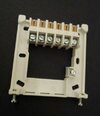Hi,
Can someone give me some guidance please. I'm replacing a faulty danfoss central heating thermostat/timer with a single channel hive on a combi boiler. The danfoss was a battery powered unit so only had two control wires going in to it, one into a terminal marked 3N/O and the other into 1 COM. I've replace the cable with some four core to supply the hive receiver with live and neutral it requires and just taken these both from the junction box after the switched fused spur that supplies the boiler. For the two control wires I've gone into the common terminal on the hive with one and the heating on (NO) with the other. Both of these wires coming from the boiler are black, so I've no idea which is which.
Problem is the receiver unit isn't lighting up as though it isn't getting power. I've tried switching the two control wires around to see if it was because these were wrong but it doesn't make any difference.
Can someone give me some guidance please. I'm replacing a faulty danfoss central heating thermostat/timer with a single channel hive on a combi boiler. The danfoss was a battery powered unit so only had two control wires going in to it, one into a terminal marked 3N/O and the other into 1 COM. I've replace the cable with some four core to supply the hive receiver with live and neutral it requires and just taken these both from the junction box after the switched fused spur that supplies the boiler. For the two control wires I've gone into the common terminal on the hive with one and the heating on (NO) with the other. Both of these wires coming from the boiler are black, so I've no idea which is which.
Problem is the receiver unit isn't lighting up as though it isn't getting power. I've tried switching the two control wires around to see if it was because these were wrong but it doesn't make any difference.




